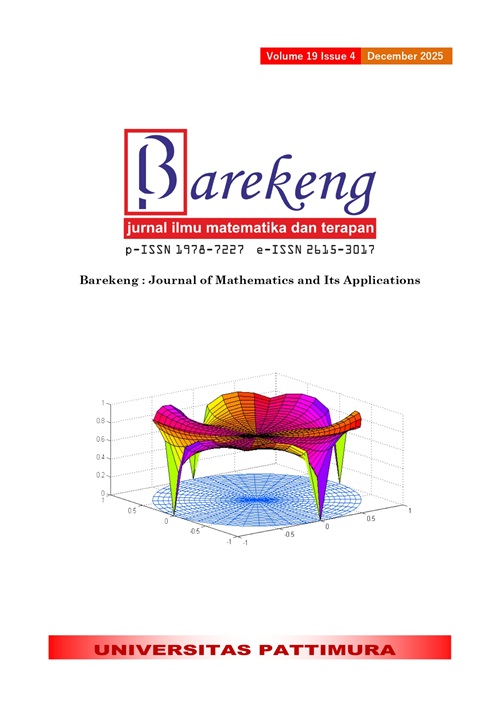MODELING FACTORS CAUSING ALZHEIMER’S DISEASE USING LOGIT, PROBIT, AND GOMPIT LINK FUNCTIONS IN GENERALIZED LINEAR MODEL
Abstract
This study addresses the ongoing challenge of clarifying the risk factors contributing to Alzheimer's disease, a neurodegenerative condition marked by progressive cognitive decline and memory dysfunction, with cases rising globally. To provide a more accurate and comprehensive understanding of the predictors associated with the disease, this research models the contributing factors using logit, probit, and gompit link functions within the Generalized Linear Model (GLM). Utilizing secondary data from 2024, which includes predictor variables such as age, family history, head injury, hypertension, memory complaints, and behavioral disturbances, this research models the relationship between these variables and Alzheimer's diagnosis. The analysis finds that the logit, probit, and gompit link functions yield significant results in identifying risk factors associated with Alzheimer's diagnosis, particularly memory complaints and behavioral disturbances. The gompit link is selected as the best model due to its highest deviance R-squared value of 30.01%, indicating better reliability in predicting Alzheimer's diagnosis than other models. This GLM approach provides insights to support early prevention and intervention efforts for Alzheimer's disease and contribute to achieving Sustainable Development Goals (SDGs) number 3 on good health and well-being.
Downloads
References
L. Arwin and J. N. Pratiwi, "PERAN NEUROPROTEKTOR ASTAXANTHIN DALAM PENCEGAHAN PENYAKIT ALZHEIMER," Jurnal Ilmu Keperawatan Jiwa, pp. 47-52, 2020, doi: https://doi.org/10.32584/jikj.v3i1.469.
S. Sahana, R. Kumar, S. Nag, R. Paul, I. Chatterjee and N. Guha, "A REVIEW ON ALZHEIMER DISEASE AND FUTURE PROSPECTS," World Journal of Pharmacy and Pharmaceutical Sciences, vol. 9, no. 9, pp. 1276-1285, 2020, doi: https://doi.org/10.55544/jrasb.1.2.9.
R. W. Werdhana, "KLASIFIKASI GEN YANG TERKAIT SINDROM ALZHEIMER MENGGUNAKAN MTODE NAIVE BAYES CLASSIFIER, BINARY LOGISTIC REGRESSION DAN LOGISTIC REGRESSION ENSEMBLE," Fakultas Matematika dan Ilmu Pengetahuan Alam, Institut Teknologi Speuluh Nopember, Surabaya, 2017.
F. Akbar and Rahmaddeni, "KOMPARASI ALGORITMA MACHINE LEARNING UNTUK MEMPREDIKSI PENYAKIT ALZHEIMER," Jurnal Politeknik Caltex Riau, 2022, doi: https://doi.org/10.35143/jkt.v8i2.5713
O. Diao, P.-A. Absil and M. Diallo, "GENERALIZED LINEAR MODELS TO FORECAST MALARIA INCIDENCE IN THREE ENDEMIC REGIONS OF SENEGAL," International Journal of Environmental Research and Public Health, vol. 20, no. 13, pp. 1-27, 2023, doi: https://doi.org/10.3390/ijerph20136303.
R. B. Prasetyo, H. Kuswanto, N. Iriawan and B. S. S. Ulama, "A COMPARISON OF SOME LINK FUNCTIONS FOR BINOMIAL REGRESSION MODELS WITH APPLICATION TO SCHOOL DROP-OUT RATES IN EAST JAVA," in AIP Conference Proceedings, Melville, NY, 2019, doi: https://doi.org/10.1063/1.5139815.
T. Zhang, Y. Ning and D. Ruppert, "OPTIMAL SAMPLING FOR GENERALIZED LINEAR MODELS UNDER MEASUREMENT CONSTRAINTS," Journal of the American Statistical Association, vol. 117, no. 540, pp. 1896-1910, 2020, https://doi.org/10.48550/arXiv.1907.07309.
K. F. Arnold, V. Davies, M. d. Kamps, P. W. Tennant, J. Mbotwa and M. S. Gilthorpe, "REFLECTION ON MODERN METHODS: GENERALIZED LINEAR MODELS FOR PROGNOSIS AND INTERVENTION," International Journal of Epidemiology, vol. 49, no. 6, pp. 2074-2082, 2020, doi: https://doi.org/10.1093/ije/dyaa049.
A. Al-Finatunni'mah and T. Nurhidayati, "PELAKSANAAN SENAM OTAK UNTUK PENINGKATAN FUNGSI KOGNITIF PADA LANSIA DENGAN DEMENSIA," Ners Muda, vol. I, 2020, doi: https://doi.org/10.26714/nm.v1i2.5666.
A. Rosyida and T. B. Sasongko, "DETEKSI DINI PENYAKIT ALZHEIMER DENGAN ALGORITMA C4.5 BERBASIS BPSO (BINARY PARTICLE SWARM OPTIMIZATION)," SISFOKOM (Sistem Informasi dan Komputer), 2023, doi: https://doi.org/10.32736/sisfokom.v12i3.1716.
M. Delporte, S. Fieuws, G. Molenberghs, G. Verbeke, S. S. Wanyama, E. Hatziagorou and C. D. Boeck, "A JOINT NORMAL-BINARY (PROBIT) MODEL," International Statistical Review, vol. 90, no. 3, pp. 410-434, 2022, doi: https://doi.org/10.1111/insr.12532.
S. Saidi, N. Herawati and K. Nisa, "MODELING WITH GENERALIZED LINEAR MODEL ON COVID-19: CASES IN INDONESIA," International Journal of Electronics and Communications System, vol. 1, no. 1, pp. 25-32, 2021, doi: https://doi.org/10.24042/ijecs.v1i1.9299.
H. Turner, "INTRODUCTION TO GENERALIZED LINEAR MODELS," ESRC National Centre for Research Methods, UK and Department of Statistcs University of Warwick, UK, 2008.
E. C. Norton and E. D. Bryan, "LOGODDSANDTHEINTERPRETATION OF LOGIT MODELS," Health Services Research, vol. 53, no. 2, pp. 859-878, 2018, doi: https://doi.org/10.1111/1475-6773.12712.
C. Johnston, J. McDonald and K. Quist, "A GENERALIZED ORDERED PROBIT MODEL," Communications in Statistics - Theory and Methods, vol. 48, no. 20, p. 5128–5144, 2019, doi: https://doi.org/10.1080/03610926.2019.1565780.
C. J. McCabe, M. A. Halvorson, K. M. King, X. Cao and D. S. Kim, "INTERPRETING INTERACTION EFFECTS IN GENERALIZED LINEAR MODELS OF NONLINEAR PROBABILITIES AND COUNTS," Multivariate Behavioral Research, vol. 57, no. 2, pp. 243-263, 2022, doi: https://doi.org/10.1080/00273171.2020.1868966.
D. Ariyanto, A. Sofro, A. N. Hanifah, J. Prihanto, D. A. Maulana and R. W. Romadhonia, "LOGISTIC AND PROBIT REGRESSION MODELING TO PREDICT THE OPPORTUNITIES OF DIEBETES IN PROSPECTIVE ATHLETES," BAREKENG : Journal of Mathematics and Its Application, vol. 18, no. 3, pp. 1391-1402, 2024, doi: https://doi.org/10.30598/barekengvol18iss3pp1391-1402.
X. Peng, C. Lei and X. Sun, "COMPARISON OF LETHAL DOSES CALCULATED USING LOGIT/PROBIT–LOG(DOSE) REGRESSIONS WITH ARBITRARY SLOPES USING R," Journal of Economic Entomology, vol. 114, no. 3, pp. 1345-1352, 2021, doi: https://doi.org/10.1093/jee/toab044.
C. Rainey and K. McCaskey, "ESTIMATING LOGIT MODELS WITH SMALL SAMPLES," Political Science Research and Methods, vol. 9, no. 4, pp. 754-769, 2021, doi: https://doi.org/10.1017/psrm.2021.9.
I. Kosmidis, E. C. K. Pagui and N. Sartori, "MEAN AND MEDIAN BIAS REDUCTION IN GENERALIZED LINEAR MODELS," Journal of the Royal Statistical Society: Series B (Statistical Methodology), vol. 84, no. 2, pp. 380-405, 2022, doi: https://doi.org/10.1007/s11222-019-09860-6.
D. W. Hosmer and S. Lemeshow, APPLIED LOGISTIC REGRESSION, New York: Wiley, 2000, doi: https://doi.org/10.1002/0471722146.
S. D. Puspa, J. Riyono and F. Puspitasari, "ANALISIS FAKTOR-FAKTOR YANG MEMPENGARUHI PEMAHAMAN KONSEP MATEMATIS MAHASISWA DALAM PEMBELAJARAN JARAK JAUH PADA MASA PANDEMI COVID-19," Jurnal Cendekia: Jurnal Pendidikan Matematika, 2021, doi: https://doi.org/10.31004/cendekia.v5i1.533.
Amelia, E. Agustina, M. Aziyannoor and Rifaldi, "ASOSIASI LINGKUNGAN FISIK RUMAH SEBAGAI FAKTOR RISIKO KEJADIAN TB PARU DI INDONESIA," Jurnal Kesehatan Tambusai, vol. 4, no. 3, 2023, doi: https://doi.org/10.31004/jkt.v4i3.15481.
M. A. Suhendra, I. Dwi and S. , "KETEPATAN KLASIFIKASI PEMBERIAN KARTU KELUARGA SEJAHTERA DI KOTA SEMARANG MENGGUNAKAN METODE REGRESI LOGISTIK BINER DAN METODE CHAID," Jurnal Gaussian, 2020, doi: https://doi.org/10.14710/j.gauss.v9i1.27524.
R. E. Kharoua, "ALZHEIMER'S DISEASE DATASET," 2024. [Online]. Available: https://www.kaggle.com/datasets/rabieelkharoua/alzheimers-disease-dataset/data. [Accessed 5 September 2024].
Ö. İ. Güneri and B. Durmuş, "DEPENDENT DUMMY VARIABLE MODELS: AN APPLICATION OF LOGIT, PROBIT AND TOBIT MODELS ON SURVEY DATA," International Journal of Computational and Experimental Science and Engineering (IJCESEN), vol. 6, no. 1, pp. 63-74, 2020, https://doi.org/10.22399/ijecesen.666512.18
Copyright (c) 2025 Ardi Kurniawan, Gabriella Agnes Budijono, Kimberly Maserati Siagian, Adrian Wahyu Abdillah

This work is licensed under a Creative Commons Attribution-ShareAlike 4.0 International License.
Authors who publish with this Journal agree to the following terms:
- Author retain copyright and grant the journal right of first publication with the work simultaneously licensed under a creative commons attribution license that allow others to share the work within an acknowledgement of the work’s authorship and initial publication of this journal.
- Authors are able to enter into separate, additional contractual arrangement for the non-exclusive distribution of the journal’s published version of the work (e.g. acknowledgement of its initial publication in this journal).
- Authors are permitted and encouraged to post their work online (e.g. in institutional repositories or on their websites) prior to and during the submission process, as it can lead to productive exchanges, as well as earlier and greater citation of published works.






1.gif)



